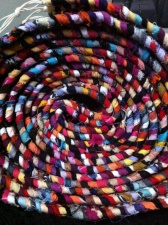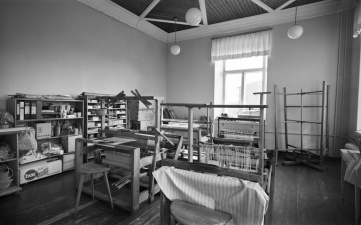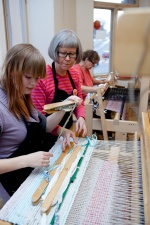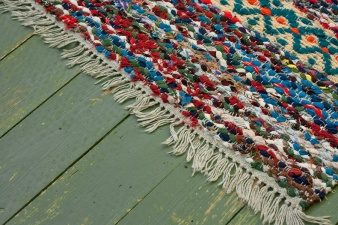Rag rug weaving
| Rag rug weaving | ||||
|---|---|---|---|---|
| In the national inventory | ||||
|
Practitioners and people who know the tradition well
These rugs are woven by handicraft and weaving enthusiasts, professional artisans and students of handicrafts. The experienced practitioners and teachers of crafts, as well as the Taito crafts associations, function as the experts. The rugs are weaved with looms at crafts centres, community colleges and centres of adult education. The oral tradition and fabric weaving skills used to spread from household to household and from the elders to the younger people. These days, the know-how is being passed on by teachers and amateur weavers. Children and young people can learn how to weave rag rugs at the crafts schools and on summer courses organised by the Taito association. Looms are also used in schools’ crafts classes, for example on the optional crafts courses at the upper stage of comprehensive school. The pupils’ ability to weave rag rugs on basic courses depends largely on whether the schools have looms.
Practising of the tradition
Rag rugs are weaved with looms to be used at home. They give a new life to old, discarded textile materials. Old clothes, sheets and other textiles are first cut into weft. The warp in rag rugs is usually made of warp yarn or linen twine. When weaving with a loom, the rug can be designed to have a size and colour to suit a specific place. All types of home textiles can be recycled by reusing them in a rag rug. For example, threadbare sheets that cannot be otherwise used anymore can be turned into weft. Textiles of varying qualities will form a uniform combination when weaved in together. Traditionally, rag rugs are weaved using three shuttles, two of which carry textile weft and one with some flexible tricot weft or vice versa. Traditional rag rugs can also be weaved with just one shuttle, in which case the weft material is first sewn together from shorter cuts. The Kiikkala-style rugs are woven with one shuttle. The weft to be used is cut to length and arranged in the order called for by the pattern to be weaved in. The unique feature of this type of rag rug is that the weft is pre-cut and an entire rug is designed prior to the weaving. The weft selected is weaved into the warp according to a pre-planned order, and a single shuttle is sufficient to finish the work. The rug’s colours and the number of times the pattern must be repeated in order to reach the desired size are determined before the weaving phase even begins. The rug must have an even number of pattern repeats in order to be symmetrical. Each set of pre-cut and pre-arranged wefts is rolled up separately. The wefts are cut according to the pattern and tied together with a slipknot, which will be untied during the weaving.
In many rugs, the weavers have alternated between a so-called base pattern and groups of stripes at regular intervals, making a cubit of base and a quarter of stripes. The traditional ruusukas weave and variations of twill have been among the most popular. Similar rag rug weaves have slightly different names around Finland, depending on the region, including ‘sugar cube’, ‘block’, ‘cloister window’, ‘lovers’ lane’ and ‘mixture’.
The background and history of the tradition
The oldest mention of rag rugs is from 1798 from Varsinais-Suomi. Floor rugs first began gaining popularity in the homes of the gentry, and later, during the last few decades of the 19th century, also amongst the peasantry. The method of weaving rag rugs was well-known, as it had been used for centuries to turn worn out rags into bedspreads and sheets. Over time, as people began to prosper and had more pieces of leftover clothing available, it became possible to use these for rug weft. The industrialisation of textile weaving allowed homes to have more colourful rugs. A vast number of different colours, stripe patterns and weaves are used. These days, new materials, such as tricot and cotton, are available as weft, and these are typically surplus material from the textile industry, for example leftover fabric edges. However, traditionally rag rugs were made from used material, i.e. rags.
The transmission of the tradition
The Taito centres provide instruction on rag rug weaving, and the skill is taught at Taito crafts schools and other educational institutions in the field. In addition, the tradition is being passed on from one generation to the next within individual families.
The future of the tradition
Making rag rugs is still a popular pastime, although the most active weavers tend to be elderly women. A small number of men are also involved in the practice. Thanks to improved recycling, young women have also become interested in weaving traditional rag rugs. The younger generations are more used to receiving rugs as gifts from crafts enthusiast friends or grandmothers, or buying similar products from a shop, rather than making rag rugs themselves. Due to lack of space, few people can have a loom at home. Crafts centres, where people can weave rugs, are vital for the continuation of the tradition. Nowadays, old rags are also being turned into rugs by using other techniques besides the loom, for example by crocheting.
The community behind this submission
Taitoliitto - Taito Group Finland
Bibliography and links to external sources of information
Autio, Johanna. 2012. Räsymatto perinteen ja muutoksen puristuksessa: tapaustutkimus Eija Rasinmäen matoista vuosina 1970-2011. Käsityötieteen pro gradu –tutkielma. Helsingin yliopisto, opettajankoulutuslaitos.
Aydemir, Johanna. 2012. Maton monet muodot. Teoksessa Aydemir, Johanna & Honkimaa, Outi & Kettula, Suvi & Toivanen, Pirkko (toim.) Suomalaiset käsityöaarteet. Silmukoita, sidoksia ja salusiineja. Helsinki: WSOY, 8 - 37.
Hassi, Elina. 2013. Rasymatto: nostalgiaa ja nykyaikaa. Helsinki: Karisto.
Honka-Hallila, Helena: Ryijystä räsymattoon, Avain, Helsinki 2011
Kaukonen, Toini-Inkeri: Kyynärä pohjaa, kortteli raitaa, Akatiimi Oy, Helsinki 1998
Lepoaho, Sari. 2001. ”Räsymatto. Riepumatto. Lattiarätti.” Räsymaton kudonnan tekniikka ja näytteet – Kansio Tekevän kutomon käyttöön. Pohjois-Savon ammattikorkeakoulu Kuopion muotoiluakatemia. Artenomintyö.
Lockwood, Yvonne. 2010. Finnish American Rag rugs. Art, tradition & ethnic continuity. East Lansing: Michigan State University Press.
Niiniharju, Krista. 2007. Kyynärä kaihoa, kortteli kulttuuria: räsymatot suomalaisen kodin tunnun ilmentäjänä 1960-70 lukujen taitteessa. Käsityötieteen pro gradu –tutkielma. Helsingin yliopisto, opettajankoulutuslaitos.
Historical resources
Museoiden Finna. Suomen museoiden kokoelmat.
Kaukonen, Toini-Inkeri (toim.) 1969. Kansallismuseon kansatieteellinen käsikirjoitusarkisto.
Articles, websites and other recordings
Kinnari, Samuli. Rakasta räsyä sevotetaan kiikkalaisittain. Kokemäen jokilaakson uutiset 27.1.2017.
Perinne.net. Perinteisiä räsymattomalleja.
Räsymattoja tilauksesta ja tarinoita matoista.
Iloinen Kirjopolku-matto ohjeineen.
Ruusupolku. 2004. Raitoja ja räsymattoja. Räsymattoja tilauksesta ja tarinoita matoista.
Matonkudonta. Wikipedia-artikkeli.
Perinteisiä mattoja Vakka-Suomesta ja Rauman seudulta. CD-rom.
Taito Varsinaissuomi. 2011. Tarinamatot DVD.




